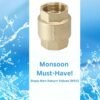
Water tanks play a crucial role in storing and preserving water for various purposes. When it comes to water tank design, the number of layers can significantly impact its efficiency and performance.
In this blog, we will explore the importance of multiple layers in water tanks, delve into the materials commonly used for layering, and understand how these layers contribute to effective water storage.
Ensuring Structural Integrity:
One of the primary purposes of incorporating multiple layers in a water tank is to enhance its structural integrity. The layers provide added strength and support, preventing deformation or collapse of the tank. Reinforced layers can withstand external forces and environmental factors, ensuring the tank maintains its shape and durability over time.
Preventing Water Contamination:
Layers in a water tank act as a protective barrier, safeguarding the stored water from external contaminants. The innermost layer, known as the food-grade liner, is typically made of materials such as polyethylene or fiberglass that are non-toxic and resistant to chemical reactions. This layer ensures the water remains pure and uncontaminated, suitable for drinking and other domestic uses.
Temperature Regulation :
Water tanks with multiple layers offer effective temperature regulation. The outer layers act as insulation, reducing the impact of external temperature fluctuations. This helps in preventing excessive heat absorption during hot weather or heat loss during colder periods. Stable water temperatures not only improve comfort but also minimize the risk of bacterial growth, ensuring the water remains fresh and usable.
UV Protection:
Exposure to ultraviolet (UV) radiation can degrade the tank material and affect the quality of stored water. Water tanks with layered designs often incorporate UV protection in the outermost layer. UV-resistant materials, such as specialized coatings or additives, shield the tank from harmful UV rays, preventing material degradation and maintaining the integrity of the tank over time.
Increased Longevity:
By utilizing multiple layers, water tanks can achieve greater durability and longevity. Each layer serves a specific purpose, working together to create a robust and reliable water storage solution. The combination of structural reinforcement, contamination prevention, temperature regulation, and UV protection contributes to an extended lifespan for the tank, reducing the need for frequent replacements and ensuring continuous water storage efficiency.

Incorporating multiple layers in a water tank is essential for maximising its performance and efficiency. From structural integrity to temperature regulation, UV protection, and water contamination prevention, each layer serves a vital purpose. By choosing water tanks with layered designs and utilising high-quality materials, individuals and businesses can ensure reliable and long-lasting water storage solutions, contributing to the conservation and efficient use of this valuable resource.





